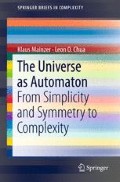Abstract
In the universe of cellular automata, one can identify many concrete concepts and examples that mimic concepts and phenomena of matter in the classical, quantum, and relativistic world of physics. Historically, quantum theory started with Bohr’s atomic model of an atomic nucleus and discrete orbits of electrons, which remind us of the planetary models of antiquity. In the world of cellular automata, the discrete electron orbits around the nucleus are realized by isles of Eden. But, Bohr’s model was only a rough approximation to the real quantum world. Because of its simplicity and central symmetry, it is still used as an illustration. Bohr’s symmetry is only an approximate model. But, the exact symmetries of the quantum world lie deeper in the mathematical structure of transformation groups.
Access this chapter
Tax calculation will be finalised at checkout
Purchases are for personal use only
References
J. Audretsch, K.(Hrsg.) Mainzer, Wieviele Leben hat Schrödingers Katze? Zur Physik und Philosophie der Quantenmechanik, 2nd edn. (Spektrum Akademischer Verlag, Heidelberg, 1996)
J.S. Bell, On the Einstein-Podolsky-Rosen-Paradoxon. Physics 1, 195–200 (1964)
D. Bouwmeester, A. Ekert, A. Zeilinger (eds.), The Physics of Quantum information. Quantum Cryptography, Quantum Teleportation, Quantum Computation (Springer, Berlin, 2000)
L.O. Chua, V.I. Sbitnev, S. Yoon, A nonlinear dynamics perspective of wolfram’s new kind of science Part VI: from time-reversible attractors to the arrow of time. Int. J. Bifurcat. chaos (IJBC) 16(5), 1097–1373 (2006)
D. Deutsch, Quantum theory, the Church-Turing principle and the universal quantum computer. Proc. R. Soc. Lond. A 400, 97–117 (1985)
M.G. Doncel, A. Herrmann, L. Michel, A. Pais, Symmetries in Physics 1600–1980 (Servei de Publicacions, UAB Barcelona, 1987)
R.P. Feynman, The theory of positrons. Phys. Rev. 76, 749–759 (1949)
R. Feynman, Simulating physics with computers. Int. J. Theor. Phys. 21(6–7), 467–488 (1982)
R. Giles, C. Thorn, Lattice approach to string theory. Phys. Rev. D 16, 366 (1977)
J. Horowitz, An introduction to quantum cellular automata (2008), http://web.mit.edu/joshuah/www/ projects/qca.pdf
T.D. Lee, C.N. Yang, Questions of Parity Conservation in Weak Interactions. Phys. Rev. 104, 254 (1956)
K. Mainzer, Symmetries of Nature (De Gruyter, New York, 1996) (German 1988: Symmetrien der Natur. De Gruyter: Berlin)
K. Mainzer, The Little Book of Time (Copernicus Books, New York, 2002)
K. Mainzer, Symmetry and Complexity: The Spirit and Beauty of Nonlinear Science (World Scientific, Singapore, 2005a)
K. Mainzer, Symmetry and Complexity in Dynamical Systems. Eur. Rev. Academia Europaea 13(2), 29–48 (2005b)
K. Mainzer, Der kreative Zufall. Wie das Neue in die Welt kommt (C.H. Beck, München, 2007)
M. McGuigan, Quantum cellular automata from lattice field theories (2003), http://arxiv.org/ftp/quant-ph/papers/0307/0307176.pdf
W. Pauli, Niels Bohr and the Development of Physics (Pergamon Press, London, 1957)
W. Van Dam, Quantum Cellular Automata. Master’s thesis. Computing Science Institute. University of Nijmegen, The Netherlands, 1996
J. Watrous, On one-dimensional quantum cellular automata. Proceedings of the 36th Annual Symposium on Foundations of Computer Science. IEEE Computer Society Press, Milwaukee (Wisconsin), 1995
Author information
Authors and Affiliations
Corresponding author
Rights and permissions
Copyright information
© 2012 Klaus Mainzer
About this chapter
Cite this chapter
Mainzer, K., Chua, L. (2012). Matter in the Universe of Cellular Automata. In: The Universe as Automaton. SpringerBriefs in Complexity. Springer, Berlin, Heidelberg. https://doi.org/10.1007/978-3-642-23477-4_7
Download citation
DOI: https://doi.org/10.1007/978-3-642-23477-4_7
Published:
Publisher Name: Springer, Berlin, Heidelberg
Print ISBN: 978-3-642-23476-7
Online ISBN: 978-3-642-23477-4
eBook Packages: Physics and AstronomyPhysics and Astronomy (R0)

